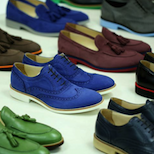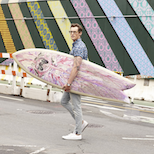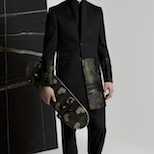Creative Director of adidas Originals Talks Design, Working with Pharrell, and The Perfect Collab
08.27.2014
STYLE
The fashion-forward sportswear styles found throughout the various adidas Originals collections are modern reinterpretations of a classic designs. Often times those reinterpretations are brought to life with the assistance of well-known influencers throughout the worlds of fashion, music and sports. Collaborations with long-established and much respected creatives have long been embraced by adidas and its sub-labels. “We have been doing this for a while,” says Dirk Schoenberger, the Creative Director for both adidas Originals and Style. Referencing adidas’ long-standing partnership with Yohji Yamamoto’s Y-3, Schoenberger goes on to say, “Our work with him in particular, was the first time that a fashion designer with couturier status worked with a sports company, breaking down the walls between fashion and sportswear. The result, influence and impact of this partnership can still be seen on the runways of many of the large, established fashion houses today.”
If past adidas collaborations are any indication, we’re sure to see the impact of many of the current and upcoming adidas Originals collections for years to come. With a current line-up of collaborators that includes Pharrell Williams, NIGO, Jeremy Scott, TopShop, Barbour and Opening Ceremony, it’s no surprise that the lifestyle imprint has been a topic of discussion in many fashion circles as of late. Here, Dirk Schoenberger discusses the history of adidas Originals, working with Pharrell Williams and what makes a perfect collaboration with Life + Times.
Life + Times: For those not familiar with adidas Originals, how does it differ from other adidas brands?
Dirk Schoenberger: adidas Originals examines the adidas brand’s vast heritage and long standing ties to both street and youth culture and re-imagines these roots for the young of today. In doing so, the collection respects and references our past, while taking it into the future, exploring the potential and pushing the boundaries of streetwear in the process.
L+T: adidas Originals reinterprets classic adidas designs. How has Originals been able to successfully pay homage to the past, but also keep the designs feeling fresh and unique?
DS: At adidas, we are so fortunate to have the rich and expansive brand heritage that we do. It provides us with iconic stories, products and logo artwork—the 3 stripes specifically—that are instantly recognized around the world. At the same time, we can’t rely solely on what has been done in the past. I don’t like retro. I don’t like when things are designed exactly the same way as they were before and when designers are making work based only on nostalgia. A brand like adidas, which has always been tied to youth and street culture, simply can’t address the youth culture of just one particular era. We want to advance things, so we make it our mission to take the best of what we have done by using some of our most iconic and celebrated designs and remixing them for the youth of today. We want to also create entirely new icons along the way and to experiment with details, different textiles, color palettes and of course, new technologies to create a bridge linking the past with the future. Sometimes these updates are subtle like in the case of the classic Stan Smith, for instance. Other times these shifts are quite bold and playful.
L+T: adidas Originals is known for collaborating with some of the biggest names throughout the worlds of fashion, music and sports. How has Originals managed to partner with such a diverse group of creatives and still keep true to the adidas Originals identity?
DS: What is interesting about collaborating with any partner is that they bring their culture into our stories. They provide us with an external, yet equally passionate perspective on adidas, which is always an exciting, flattering and humbling experience. Projects like these bring about a great dialogue with these artists and the results are always new and surprising. Our collaborations extend far beyond the circles of pop, rock and hip hop music. We also work with iconic fashion designers, athletes, interior designers and other influential leaders across multiple disciplines. This creates a fusion of diverse talent that is highly relevant in culture today.
We have been doing this for a while. If you think back, we started working with Run DMC in the mid-80s and with Yohji Yamamoto over 13 years ago. Our work with him in particular, was the first time that a fashion designer with couturier status worked with a sports company, breaking down the walls between fashion and sportswear. The result, influence and impact of this partnership can still be seen on the runways of many of the large, established fashion houses today.
L+T: What do you think is the key to a successful collaboration?
DS: It is important that both sides bring something to the collaboration. For me to be excited about potentially partnering with someone, there has to be an organic, natural connection there. There should already be an existing love for the brand, which makes working with any collaborator all the more engaging.
L+T: Many were excited to learn of the Nigo partnership. With his history at Bape, it seems like he’d be a perfect addition to the adidas Originals family. What can we expect from this collaboration?
DS: adidas Originals is a pioneer in global streetwear. From the iconic Superstar to the ubiquitous three-stripe track top, adidas Originals’ sportswear styles have been adapted to the style of the street for decades. We always seek out fellow pioneers in streetwear to create something new. Simultaneously, one creative force has been defining streetwear since the early 90’s, and that’s Nigo. Nigo turned the exciting streetwear scene in Tokyo into a global phenomenon. He is a true pioneer and continues to influence the style of even top entertainers today. Together, adidas Originals and Nigo will team up to explore new territories in adapting sportswear for the street and we will inspire a new generation of streetwear enthusiasts.
L+T: It’s been ten years of adidas Originals by Jeremy Scott. How has the creative synergy between Jeremy and Originals evolved over the last decade?
DS: adidas Originals is a collection which also offers many possibilities. The collaboration with Jeremy Scott illustrates how far we can go and also how much fun we can have with a label without losing our individuality. I consider it an honor to work together with this talented designer.
L+T: How has it been working with Pharrell Williams?
DS: In the design process with another creative mind, adidas gives complete freedom. We offer a great playing field. I don´t want to hinder the process for Pharrell or any of our design partners in any way. That would only make a collaboration weaker. The only time I would step in is if an idea strayed too far off or away from adidas as a brand. But I have yet to encounter this. Working with Pharrell has been incredibly inspiring. He has such an amazing vision and energy. I am excited to show the world more from our work together in the coming months.
L+T: Luxury brands are paying more and more attention to sportswear. What do you think has sparked the increased interest in fashion-forward activewear?
DS: I believe it has been a logical evolution, because sportswear has become increasingly important in streetwear and also in high fashion throughout the last decade. The way people dress, not only on casual occasions, but also for work and even for more formal events has evolved to become a mixture of structured, well-fitting clothing that is paired with these more casual touches. So the end result is neither overly formal or too casual or dressed down. The technology side of sports and performance wear is also fascinating and it brings something unique to fashion as well. As the trends have been leaning more and more towards a modernist, almost futuristic aesthetic, it is easy to see how people crave the newest in fabric and construction technology. Another reason we see sportswear and sneakers on the rise and “on trend,” is because the athletic industry is often the first in the apparel industry to introduce these new advancements, so you see this co-mingling of fabrics and technologies that you’d normally only see in athletic wear being applied to day-to-day separates. All of that said, adidas truly is a pioneer in bringing sport to a fashion audience. Our collaboration with Yohji Yamamoto was the first of its kind, uniting sport and fashion. The appeal of this new look has surely opened doors and influenced other fashion brands to follow.
L+T: Hip Hop has played a role in many of the recent adidas Originals campaigns. What is it about what Originals represents and what the genre represents that makes them such a great fit for each other?
DS: I really do think of adidas as a large, cultural melting pot, one that is celebrated by so many. Athletic and sporting pursuits obviously come to mind first and foremost, but so too do music, streetwear and artistic, creative expression. That’s the beauty in developing many of the collaborations we have been talking about, because they are a perfect illustration of this melting pot idea and the varying walks of life who embrace us. Musically speaking, adidas has a rich resonance and loyalty within different niches of the music community partly because of the many storied, iconic styles that artists have worn as an authentic part of their wardrobe since birth. Examples include the Samba, which has a rich history in the punk and reggae communities, the Stan Smith, a style embraced by rock stars since the 70s and the Superstar, which was immortalized by Run-DMC.





